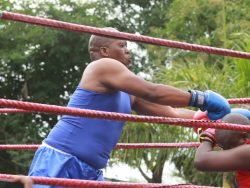Thank you Gilgal folks
…special gratitude goes to the Minister of Sports, Culture and Youth Affairs
SHUKUMA ESWATINI
BY DUMISANI NTIWANE
(ESRC Media Officer)
Shu….Shu……Shukuma Eswatini! Greetings and welcome to yet another edition of your favourite read, Shukuma Eswatini.
We are the Eswatini Sport and Recreation Council (ESRC) We are on cloud nine following the tremendous success of our flagship programme Shukuma Eswatini in Gilgal last Saturday. Prior to last weekend’s event, we were at Maphalaleni Inkhundla, where we were also thrilled with the success. Although the numbers at Gilgal were close to overwhelming, Maphalaleni folks also came out in their numbers to play. We are very grateful to the two areas’ Members of Parliament (MPs) and their respective Tindvuna te Nkhundla for their warm welcome and cooperation in delivering this, our flagship programme.
Special gratitude should go to the Minister of Sports, Culture and Youth Affairs, honorable Harries ‘Madze’ Bulunga, who continues to lead by example. Of course Bulunga is always accompaied by other governments enior officials like the Director of Sports Lucky Sihlongonyane and the Under Secretary Nhlanhla Motsa. Bulunga, during such programmes is always on the forefront, leading the pack by example. He is a fitness fanatic indeed, as he easily sets the pace during our 5km walks. The walks always kick starts Shukuma, as they serve as a warm up session.
Our mandate is to reach all the Tinkhundla Centers in the country. Do not panic, soon we will be visiting your own Inkhundla. It is who we are. It is what we do.
Once again, many thanks to the people of Gilgal for coming out in their numbers to play and have fun.
**
Anti-doping: what every athlete needs to knows
Just recently the country was rocked by a doping scandal following an out of competition doping test by the Regional Anti-Doping Organisation (RADO).
Top Correctional Athletics Club athlete Thandaza Zwane was subsequently suspended for four years by Athletics Eswatini following the doping violation.
The athlete was discovered to have a banned substance in his system. The substance is listed under the World Anti-Doping Agency (WADA) as banned for use by professional athletes.
Today, this column brings you in detail some of the banned and prohibited substances, which unfortunately are easily accessible to locals. Our athletes need to be extra careful, as it is often noted by the wise that ‘ignorance of the law is no excuse’. Our athletes need to take upon themselves to educate and teach each other on some of these banned substances, which as, already stated are easily accessible.
List of drugs banned by WADA
This list of drugs banned by WADA is determined by the World Anti-Doping Agency, established in 1999 to deal with the increasing problem of doping in the sports world. The banned substances and techniques fall into the following categories: androgens, blood doping, peptide hormones, stimulants, diuretics, narcotics, and cannabinoids.
Blood doping:
Blood doping is the injection of red blood cells, related blood products that contain red blood cells, or artificial oxygen containers. This is done by extracting and storing one’s own blood prior to an athletic competition, well in advance of the competition so that the body can replenish its natural levels of red blood cells, and subsequently injecting the stored blood immediately before competition. The resulting unnatural level of red blood cells improves oxygen transport and athletic endurance; thus, it is prohibited in most events. It is often used in extreme sports like cycling, snowboarding, and skiing where endurance is highly valued. The most famous example of this type of doping is Lance Armstrong‘s performance in the Tour de France.
Banned androgenic agents.
Banned androgenic agents are either anabolic steroids, which increase testosterone and epitestosterone, thereby improving muscle strength and endurance, or beta-2 agonists. Andro, DHEA, stanozolol, testosterone, and nandrolone, or derivates are banned anabolic steroids. Beta-2 agonists can act as bronchodilators and increase heart rates, in addition to their mild androgenic effects. Other banned androgenic agents include bambuterol, clenbuterol, salbutamol, tibolone, zeranol, zilpaterol, and selective androgen receptor modulators. While a few of the banned drugs are endogenous, that is they are normally produced in the human body, most of the banned drug are exogenous drugs chemically produced.
Hormones and related substance
Certain peptide hormones increase bulk, strength, and oxygen-carrying red blood cells.
Erythropoiesis-stimulating agent
Erythropoiesis-stimulating agents such as erythropoietin (EPO), darbepoetin (dEPO), hypoxia-inducible factor (HIF) stabilizers, methoxy polyethylene glycol-epoetin beta (CERA) and peginesatide (Hematide); growth hormone (hGH), insulin-like growth factors (IGF-1, etc.), fibroblast growth factors (FGFs), hepatocyte growth factors (HGF), mechano growth factors (MGFs), platelet-derived growth factor (PDGF), vascular endothelial growth factor (VEGF), chorionic gonadotropin (banned in men only), somatotrophin (growth hormone), insulins and corticotrophins, corticosteroid mimics, and their releasing factor, are banned.
Also banned are any other growth factor affecting muscle, tendon or ligament protein synthesis/degradation, vascularization, energy utilization, regenerative capacity or fiber type switching; and other substances with similar chemical structure or similar biological effects.
Beta-2 agonists
All beta-2 agonists and their D- and L-isomers, are banned. However, formoterol, salbutamol, salmeterol, and terbutaline may be used with a “therapeutic use exemption”, only in the inhaled form.
Hormone antagonists and modulators
Hormone levels of a particular hormone, like testosterone, can be changed not only by administering it, but also by altering related hormones. For example, the estrogens estrone and estradiol are biosynthetically produced by the enzyme aromatase, respectively, from androstenedione and testosterone, which are both produced from 17α-hydroxyprogesterone. Thus, when the body senses low levels of estrogen, the precursor compounds 17α-hydroxyprogesterone, androstenedione, and testosterone are up-regulated. Likewise, interfering with a hormone’s receptor leads to similar effects. Because of these natural hormone-hormone interdependent biosynthetic pathways and hormone-receptor interactions, all aromatase inhibitors, including anastrozole, letrozole, aminoglutethimide, exemestane, formestane, and testolactone are banned. Selective estrogen receptor modulators, including raloxifene, tamoxifen and toremifene are banned. Clomiphene, cyclofenil, fulvestrant, and all other anti-estrogenic substances are banned. Myostatin inhibitors are banned. Metabolic modulators including peroxisome proliferator-activated receptor delta (PPARδ) agonists (e.g., GW 1516), PPARδ-AMP-activated protein kinase (AMPK) axis agonists (e.g. AICAR) are also banned. Meldonium was banned on 1 January 2016, which led to a Russian doping scandal.
Stimulants:
Stimulants directly affect the central nervous system, increasing blood flow and heart rate. These drugs primarily help athletes in complex team sports like basketball and association football as well as choreographed sports like figure skating and artistic gymnastics. Stimulants that are banned include amphetamines, beta-2 agonists, ephedrine, pseudoephedrine, fencamfamine, cocaine, methamphetamines, mesocarb, and other substances with similar chemical structures and biological effects, including the following:
| Adrafinil
Adrenaline (local use allowed) Armodafinil (active enantiomer of Modafinil) Bromantane (Ladasten) Cathine (5 ug/ml urine limit) |
Etilefrine | Methylphenidate
4-Phenylpiracetam (carphedon) |
Diuretics and masking agents[edit]
Diuretics, which increase the production of urine, and masking agents, chemical compounds which interfere with drug tests, are banned for two reasons. First, by decreasing water retention and thus decreasing an athlete’s weight, an important consideration in many speed sports (e.g. track and field, speed skating), they increase the speed of an athlete. Secondly, increased urine production depletes the concentration of both the banned drugs and their metabolites, making their detection more difficult. Masking agents, on the other hand, work by making drug tests ineffective, leading to false-negative results. Desmopressin, plasma expanders (such as glycerol; intravenous administration of albumin, dextran, hydroxyethyl starch and mannitol), probenecid, and other substances with similar biological effects are also banned. Local application of felypressin in dental anesthesia is not prohibited
**
For comments/suggestions and inquiries contact the author at 76691992/79691992/24041590
Or alternatively email to ntiwane@sportscouncil.org.sz
Our marketing officer Zwakele Simelane can be reached at 76072323/24041590 or email to zwakelegr@gmail.com or zwakele@sportscouncil.org.sz
QUOTE OF THE WEEK
“Anyone who stops learning is old, whether 20 or 80. Anyone who keeps learning today is young. The greatest thing in life is to keep your mind young”. – Henry Ford


Leave us a reply